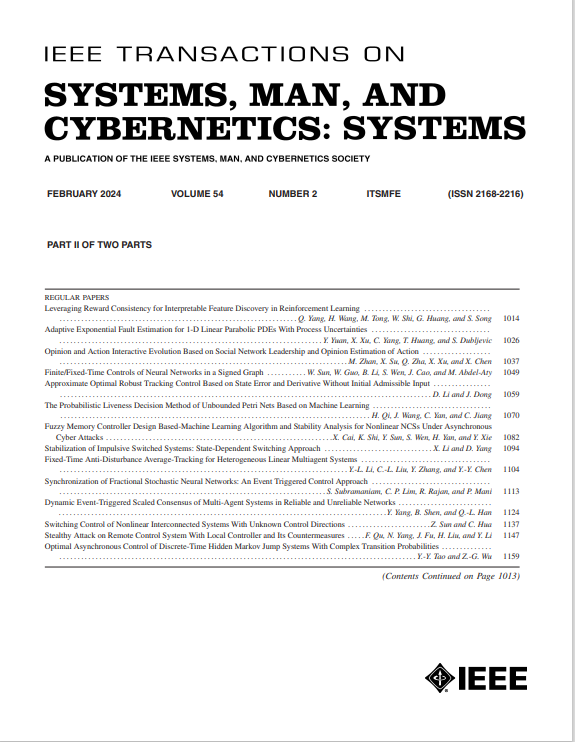标签抗噪声图表示学习的多专家治理协作
IF 8.7
1区 计算机科学
Q1 AUTOMATION & CONTROL SYSTEMS
IEEE Transactions on Systems Man Cybernetics-Systems
Pub Date : 2025-08-21
DOI:10.1109/TSMC.2025.3595183
引用次数: 0
摘要
近年来出现的抗标签噪声图表示学习(LNR-GRL)越来越受到人们的关注,它旨在增强图神经网络(gnn)在带噪声和有限标签的半监督节点分类中的泛化能力。现有的大多数LNR-GRL倾向于引入在非图区域开发的更复杂的样本选择策略来区分更多的噪声节点,以减轻其误导。然而,这些方法忽略了不准确的图结构关系纠偏以及不准确图结构关系与噪声节点标签纠偏之间的信息协同在提高噪声节点识别及其纠偏节点标签质量中的重要性。为了解决上述问题,我们提出了一种新的多专家治理协作(MEGC)框架。具体而言,首先设计了无监督图结构治理专家来纠正不准确的图结构关系。在纠偏图结构的基础上,提出了一种简单的标签噪声治理专家来准确识别有噪声节点的标签,进一步提高了有噪声节点的纠偏标签和未标记节点的伪标签的质量。最后,通过引入的交叉视图图对比损失和交叉熵损失,可以将上述治理专家与gnn有效结合,共同指导其训练,最大限度地限制噪声节点标签的影响,从数据本身发现更有效的监督指导,用于gnn优化。在三个基准、两种标签噪声类型、四种噪声率和四种训练标签率上进行的大量实验表明,与现有的LNR-GRL方法相比,所提出的方法具有优越性。本文章由计算机程序翻译,如有差异,请以英文原文为准。
Multiplex Experts Governance Collaboration for Label Noise-Resistant Graph Representation Learning
Recently emerged label noise-resistant graph representation learning (LNR-GRL) has received increasing attention, which aims to enhance the generalization of graph neural networks (GNNs) in semi-supervised node classification with noisy and limited labels. Most of the existing LNR-GRL tend to introduce more complex sample selection strategies developed in nongraph areas to distinguish more noisy nodes to alleviate their misguidance. However, these proposed methods neglect the importance of inaccurate graph structure relationships rectification, and information collaboration between inaccurate graph structure relationships and noisy node label rectification in improving the quality of noisy node identification and its rectified node labels. To solve the above-mentioned issues, we propose a novel multiplex experts governance collaboration (MEGC) framework for LNR-GRL. Specifically, an unsupervised graph structure governance expert is first designed to rectify inaccurate graph structure relationships. Based on the rectified graph structure, a simple label noise governance expert is proposed to accurately identify noisy node labels and further improve the quality of noisy nodes’ rectified labels and unlabeled nodes’ pseudo-labels. Finally, the above-proposed governance experts can be effectively combined with GNNs to jointly guide their training via the introduced cross-view graph contrastive loss and cross-entropy loss, which can maximally limit the effect of noisy node labels and discover more effective supervision guidance from data itself for GNNs optimization. Extensive experiments on three benchmarks, two label noise types, four noise rates, and four training label rates demonstrate the superiority of the proposed method in comparison to the existing LNR-GRL methods.
求助全文
通过发布文献求助,成功后即可免费获取论文全文。
去求助
来源期刊

IEEE Transactions on Systems Man Cybernetics-Systems
AUTOMATION & CONTROL SYSTEMS-COMPUTER SCIENCE, CYBERNETICS
CiteScore
18.50
自引率
11.50%
发文量
812
审稿时长
6 months
期刊介绍:
The IEEE Transactions on Systems, Man, and Cybernetics: Systems encompasses the fields of systems engineering, covering issue formulation, analysis, and modeling throughout the systems engineering lifecycle phases. It addresses decision-making, issue interpretation, systems management, processes, and various methods such as optimization, modeling, and simulation in the development and deployment of large systems.
 求助内容:
求助内容: 应助结果提醒方式:
应助结果提醒方式:


